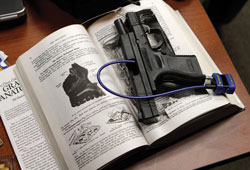Tracking down the ‘Craigslist Killer’

Philip Markoff hid the 9mm semi-automatic
pistol used to murder Julissa Brisman
in a hollowed-out copyof “Gray’s Anatomy.”
AP Photo/Steven Senne
When police responded to the April 14, 2009, murder of a young woman in an upscale Boston hotel, they had little to go on. The victim was found face down in the doorway of her room, her hands bound with plastic ties, with three 9mm bullet wounds to the hip, lung and heart. They also found blood on the carpet, a spent bullet casing, a cellphone and a Gucci bag containing the identification of a 26-year-old New York woman named Julissa Brisman.
Within a week, though, police had their man: a 23-year-old second-year Boston University medical school student named Philip Markoff, who would soon become known as the “Craigslist Killer.”
The story of how they cracked the case, through a combination of lucky breaks, dogged police work, and a trail of traditional and digital forensic evidence, was told to a spellbound audience attending the ABA Techshow plenary session program “On the Trail of the Craigslist Killer: A Case Study in Digital Forensics.”
The co-presenters were Sharon Nelson and John Simek, president and vice president, respectively, of Sensei Enterprises, a digital forensics, information security and technology firm in Fairfax, Va. They walked the audience through the case step by step, from the discovery of Brisman’s body to Markoff’s suicide in jail while awaiting trial in August 2010.
It is a tale, Nelson said, of murder, bondage, robbery, betrayal and suicide that perfectly illustrates the interplay between digital and forensic evidence at the heart of a modern police investigation. And as Nelson spun out the tale, Simek slipped in lessons for lawyers who might seek similar access to the digital information—and for anyone concerned about just how much data is gathered on individuals, and how easy it might be for someone to get it.
Or as Nelson put it: “Whatever privacy we have is because of the sheer volume of electronic data. If you come to the attention of the government, from that moment on you have no privacy.”
Click here to continue reading “Tracking down the ‘Craigslist Killer’ ” from the June issue of the ABA Journal.



